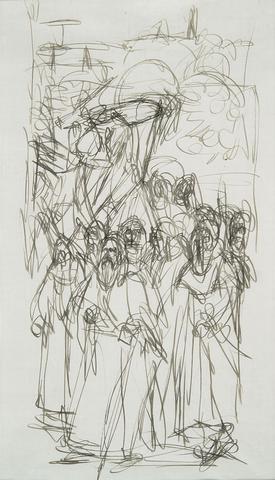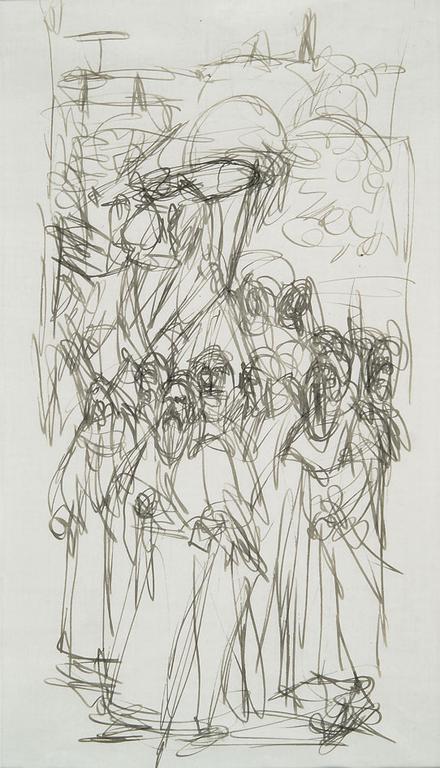
Les Ermites (d'après Jan van Eyck)
Alberto Giacometti (1901 Borgonovo - 1966 Coire)
1950
Plume et encre brune sur papier ; 29,5 x 21 cm
Provenance :
Paris, Collection Louis Clayeux ; Greenwich/Munich, collection Walter et Molly Bareiss ; New-York, Galerie Eckman ; Zurich, Galerie Hauser et Wirth ; Cologne, Lempertz, 31 mai 2011 ; Paris, collection Le Polyptyque ; Paris, collection privée.
Exposition :
Alberto Giacometti (Paris, Musée d'Art Moderne de la Ville, 1991-1992).
Bibliographie :
Luigi Carluccio, Alberto Giacometti, Le Copie del passato, Turin, 1967 ; Suzanne Pagé, Alberto Giacometti, Paris, 1991, n° 306 ; Alberto Giacometti, Les Copies du Passé, Paris, 2012, n° 83, p. 206 (reproduit p. 207).
Peintre et sculpteur, Alberto Giacometti accordait une importance centrale à l’exercice de la copie d’œuvres d’art « du passé » par le dessin. C’est ainsi que tout jeune, dans l’atelier de son père à Stampa, il s’était formé. Il les avait découvertes dans les livres et devait continuer, sa vie durant, de les y fréquenter. Mais plus encore, il le précisa lors d’un entretien avec Pierre Schneider en 1962, il s’agissait pour lui de « copier pour mieux voir », la copie d’œuvres d’art s’assimilant à l’étude d’après nature, à la fois exercice et inspiration.
Beaucoup des copies d’œuvres d’art retrouvées dans ses carnets, les marges des ouvrages d’art de sa bibliothèque ou sur des feuilles volantes, sont relativement littérales, ne laissant qu’entrevoir la subjectivité de l’artiste. Mais une série de dessins d’une qualité particulière, plus inspirés que copiés, fut rassemblée dans un ouvrage en hommage à l’inspiration que Giacometti avait trouvée auprès des maîtres anciens : « Le Copie del passato » (Les Copies du passé).
Un premier projet sur le même thème, conçu avec Louis Aragon et Albert Skira dans les années 40, n’avait pas eu de suite. Giacometti tenait particulièrement à le mener à bien et cela devait occuper les 6 dernières années de sa vie. Dans un entretien à la radio suisse en 1965, il expliquait que « ce livre (l’) intéresse par-dessus tout, car il (lui) permet de faire le point sur son passé ». Il ne paraîtra qu’après la mort de l’artiste, dans une édition italienne en 1967 puis allemande l’année suivante.
Ce dessin est l’un des 144 originaux et comme dix-neuf autres de la série appartenait à Louis Clayeux, directeur de la Galerie Maeght de 1948 à 1964, ami de longue date de l’artiste, avec lequel il avait conçu l’ouvrage. La Fondation Giacometti, qui a reconnu ce dessin, a repris le projet d’une édition française.
Giacometti choisit, en hommage aux primitifs flamands, d’interpréter – ce choix n’est pas sans rapport avec sa personnalité – le volet des Ermites du grand retable de l’Agneau Mystique des frères Van Eyck (toujours en place à la cathédrale Saint-Bavon de Gand). Les longues silhouettes barbues et vêtues de bures, quasi monochromes et déjà sculpturales, du retable sont devenues sous sa plume, à part entière, des créatures de Giacometti. La magie de l’interprétation opérant, c’est le regard singulier de Giacometti qui opère ici par-dessus le motif original.
